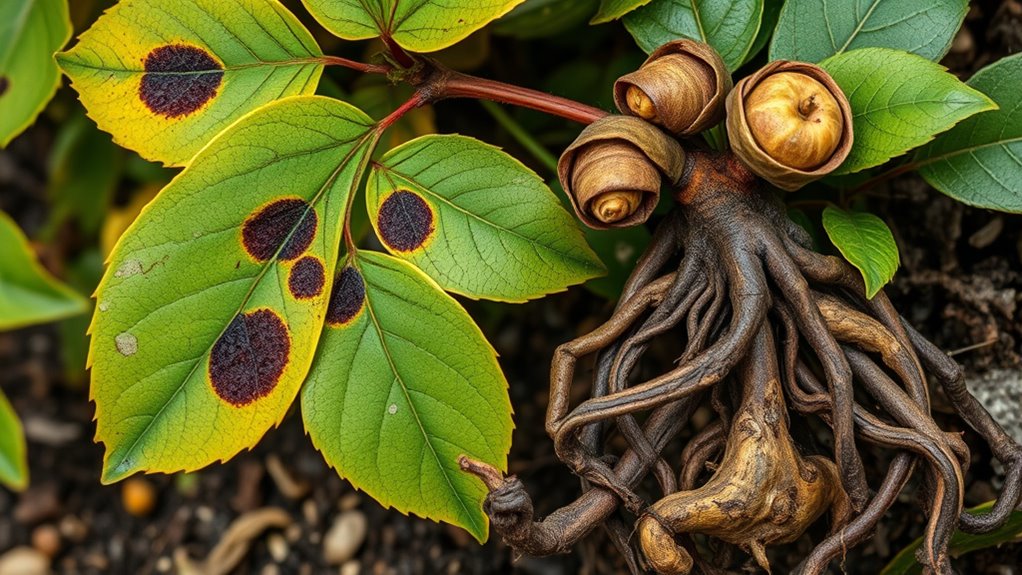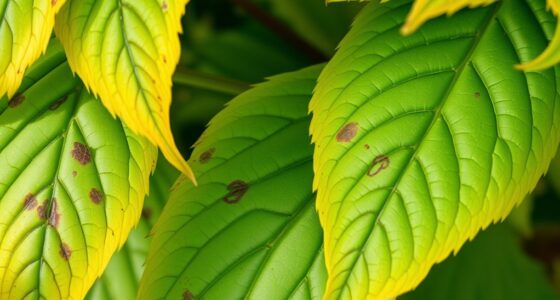To identify and manage Indian Hawthorn diseases like leaf spot, blight, and root rot, look for small dark spots, yellowing leaves, or widespread decay. Remove infected parts promptly, improve your plant’s airflow, and avoid overhead watering. Using proper soil drainage and monitoring moisture levels help prevent root rot. Applying fungicides early can control outbreaks. Keep an eye on symptoms—further tips will help you keep your shrub healthy and thriving.
Key Takeaways
- Leaf spot appears as small dark spots with yellow halos; remove affected leaves and ensure proper spacing.
- Blight causes widespread dieback and blackened leaves; prune affected areas and improve air circulation.
- Root rot signs include wilting, yellowing, and a musty smell; improve drainage and avoid overwatering.
- Prevent diseases by proper watering practices, removing debris, and maintaining adequate plant spacing.
- Early detection and targeted fungicide application are essential for managing leaf spot and blight effectively.
Recognizing Signs of Leaf Spot and How to Manage It
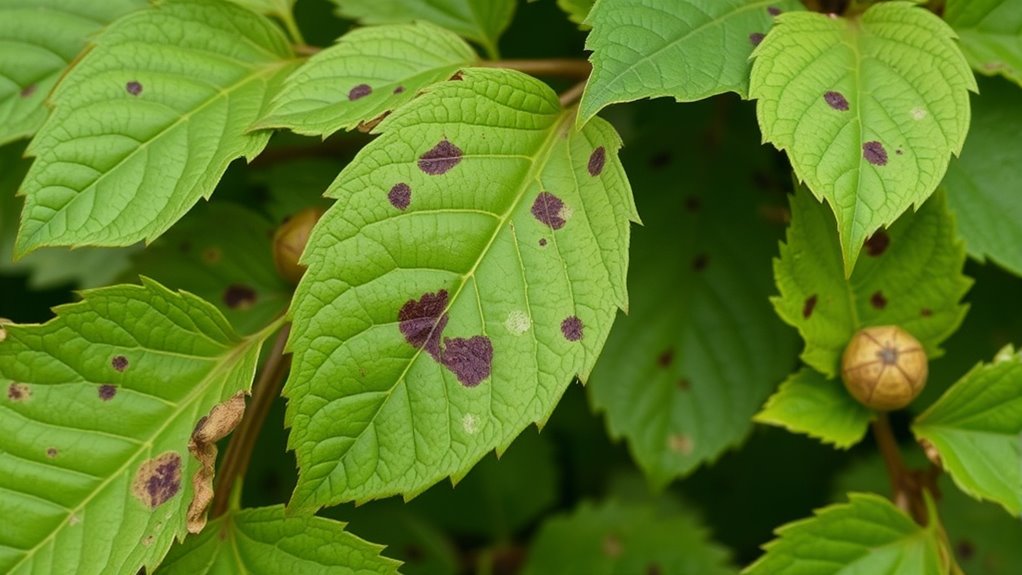
To effectively manage leaf spot in Indian hawthorn, it’s important to recognize its early signs. Fungal pathogens often cause this disease, leading to small, dark spots on the leaves that may expand or develop a yellow halo. You might notice leaves turning yellow or browning, especially along the edges. Good cultural practices are your first line of defense; guarantee proper spacing for airflow, avoid overhead watering, and remove fallen leaves that can harbor fungi. Applying fungicides can help control outbreaks if caught early, but prevention through cultural practices remains key. Keep your plants healthy by providing appropriate fertilization and avoiding stress, which can make them more susceptible. Recognizing early signs allows you to act promptly, reducing the spread of leaf spot on your Indian hawthorn.
Identifying Blight Symptoms and Treatment Options
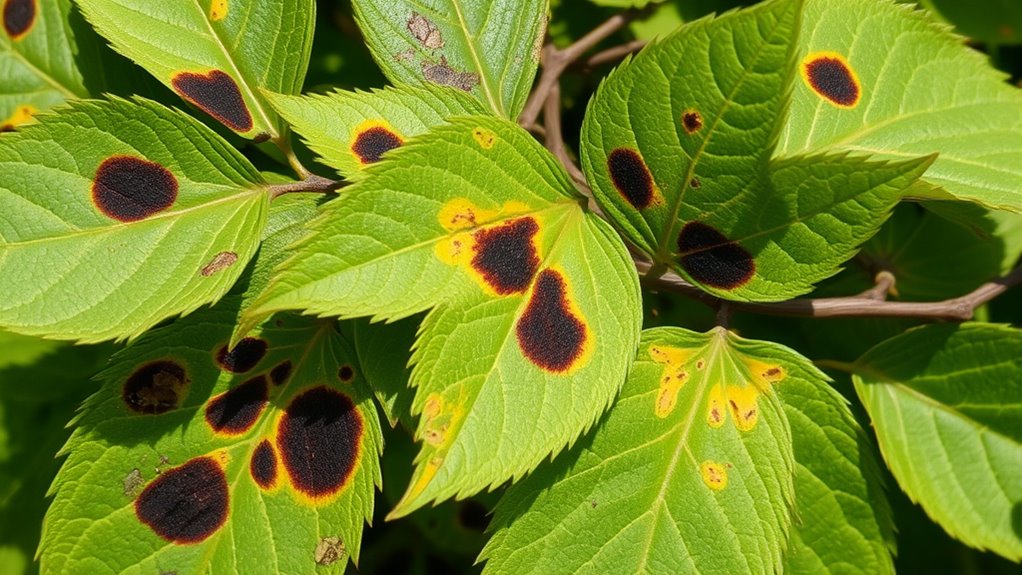
Have you noticed sudden, widespread dieback or blackened, shriveled leaves on your Indian hawthorn? These are classic signs of blight caused by fungal infection. To control the fungus, start by removing and destroying affected plant material to prevent spreading. Improve soil drainage around your plant, as poor drainage creates moist conditions that favor fungal growth. Fungus control can also involve applying a fungicide labeled for blight, following the manufacturer’s instructions carefully. Regularly prune your hawthorn to increase air circulation, reducing humidity that promotes fungi. Keep an eye on new growth, and act quickly at the first sign of blight to minimize damage. Properly managing soil drainage and using appropriate fungicides are key steps in treating and preventing blight on your Indian hawthorn. Additionally, understanding the role of contrast ratio can help you optimize your environmental conditions to prevent fungal issues. Maintaining optimal moisture levels is crucial in preventing the development and spread of fungal diseases like blight. Staying informed about plant disease management can further enhance your efforts to protect your hawthorn from future infections.
Detecting Root Rot and Implementing Preventive Measures
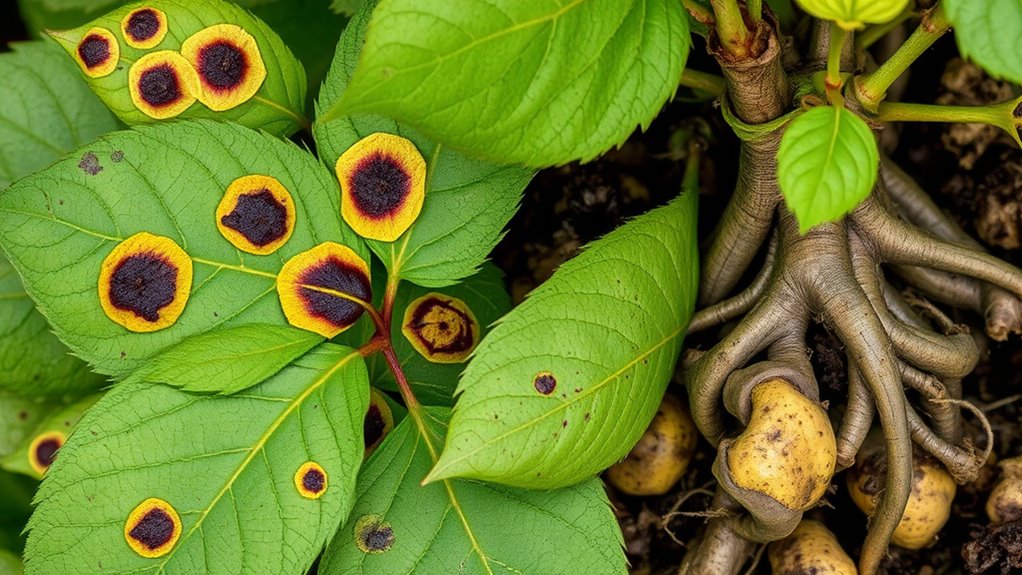
Detecting root rot early is essential because it often shows subtle signs before the plant visibly declines. You should regularly check for wilting leaves, yellowing foliage, or a musty smell near the base. To prevent root rot, focus on improving soil drainage—use well-draining soil or amend heavy clay with organic matter. Adjust your watering practices by avoiding overwatering; only water when the top inch of soil feels dry. Here are three key steps:
Regularly check for early signs like wilting leaves and improve soil drainage to prevent root rot.
- Ensure proper soil drainage to prevent standing water around roots.
- Water deeply but infrequently, allowing soil to dry out between watering sessions.
- Regularly inspect for early signs of stress or rot, acting quickly if symptoms appear.
- Incorporate automation’s role in data analysis to monitor soil moisture levels with smart irrigation systems, helping maintain optimal watering schedules. Additionally, choosing drought-tolerant plants can reduce the risk of overwatering issues. Employing soil testing methods can also help you better understand your soil’s drainage capacity and nutrient levels, further supporting plant health.
Following these steps helps keep your Indian Hawthorn healthy and resilient against root rot.
Frequently Asked Questions
Can Indian Hawthorn Diseases Spread to Other Plant Species Nearby?
You might wonder if Indian hawthorn diseases can spread to nearby plants. While cross species transmission is possible, it’s less common for these diseases to move between different plant types. However, nearby plant vulnerability increases if conditions favor disease spread, like poor air circulation or excess moisture. To protect your garden, monitor all plants closely, remove infected material promptly, and avoid overcrowding, reducing the risk of disease spreading.
Are There Organic Methods to Control Leaf Spot and Blight?
Think of organic controls like a gentle rain nourishing your garden. You can use natural remedies like neem oil or copper fungicide sprays to combat leaf spot and blight, effectively controlling disease without harsh chemicals. Regular pruning and removing infected leaves also help. These organic methods boost plant resilience, making your Indian hawthorn stronger and healthier, much like a well-tended garden thriving under nurturing, natural care.
How Often Should I Inspect My Indian Hawthorn for Diseases?
You should perform seasonal inspections of your Indian Hawthorn to catch diseases early. Regularly check your plant every few weeks, especially during active growing seasons. Look for unusual spots, discoloration, or wilting leaves. Early detection helps you address problems before they spread, making treatments more effective. By staying vigilant and inspecting your plant regularly, you’ll keep your Indian Hawthorn healthy and thriving.
What Environmental Conditions Favor the Development of Root Rot?
Many believe that poor soil drainage causes root rot, and that’s true. When soil moisture stays high due to poor drainage quality, your plant’s roots can’t get enough oxygen, leading to rot. You should guarantee proper drainage and avoid overwatering. If soil remains soggy, root rot is likely to develop. Regularly inspect your plant’s environment, especially after heavy rains, to prevent these conditions from harming your hawthorn.
Are Chemical Treatments Safe for Indian Hawthorn and Surrounding Plants?
You should consider chemical safety and treatment effectiveness before applying any treatments. If you choose chemical options, make certain they’re labeled as safe for your plants and surrounding environment. Always follow manufacturer instructions carefully to avoid harm. While chemical treatments can be effective, they may also pose risks to beneficial insects and nearby plants if misused. Using integrated pest management, combining cultural and biological methods, can often be safer and just as effective.
Conclusion
Keeping an eye out for leaf spot, blight, and root rot guarantees your Indian hawthorn stays healthy. Regular inspections can catch issues early, saving you time and effort. Did you know that untreated leaf spot can reduce plant growth by up to 50%? By promptly managing these diseases, you’ll enjoy vibrant, thriving plants. Stay vigilant, practice good sanitation, and apply treatments when needed—your Indian hawthorn will thank you for it!
